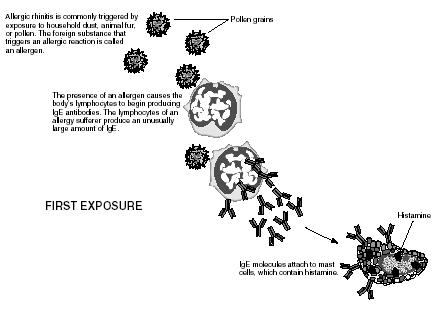Allergies - Description
Allergies are among the most common medical disorders. By some estimates more than one in every five Americans suffer from some form of allergy. This statistic holds true throughout the world. Allergies are the single most common reason for absence from school, and they are the major cause of hours lost from work.
An allergy is a type of immune reaction. Normally, the immune system protects the body against harmful invaders, like bacteria and viruses. These invaders carry distinctive markers on their outside surface called antigens (pronounced an-TIH-juns). The immune system produces special molecules called antibodies when it finds an antigen. The antibodies attach themselves to the antigens. The antigen-antibody combination sets off a series of changes in the body, which protect the body from infection and disease.
This same sequence of events can also occur with harmless invaders, such as dust and pollen. This response by the immune system is known as an allergy. The markers on the otherwise harmless invaders are known as allergens (pronounced AL-er-jins).
- Allergen:
- A substance that causes an allergic reaction.
- Anaphylaxis:
- An increased sensitivity to an allergen causing dilation (expansion) of blood vessels and tightening of muscles. Anaphylaxis can result in sharp drops in blood pressure, difficulty in breathing, and death if left untreated.
- Antibody:
- A chemical produced by the immune system in response to an antigen.
- Asthma:
- A lung condition in which airways become narrowed, causing wheezing, coughing, and shortness of breath.
- Contact dermatitis:
- Inflammation of the skin caused by exposure to an allergen.
- Histamine:
- A chemical released by mast cells that causes cells to become leaky and irritates nerve cells, causing pain.
- Mast cells:
- A type of cell that makes up the immune system that releases histamine when stimulated by immunoglobin type E, a molecule released by white blood cells.
Allergens can enter the body through four main routes: the nose and mouth, the gastrointestinal (digestive) tract, the skin, and the circulatory (blood) system.
- Allergens in the air can cause hay fever (see hay fever entry), asthma (pronounced AZ-muh; see asthma entry), or conjunctivitis (pink eye; see conjunctivitis entry).
- Allergens in food can cause itching and swelling of the lips and throat, cramps, and diarrhea. If they get into the blood, the allergens can cause hives or more serious reactions. Hives are red, itchy blotches on the skin. Food allergens can also cause anaphylaxis (pronounced a-nehfeh-LAK-siss). Anaphylaxis (or anaphylactic shock) is a life-threatening condition in which tissues swell up and begin to close the throat. A person may go into convulsion or a coma.
- Allergens that come into contact with the skin can cause reddening, itching, and blistering. This condition is called contact dermatitis (pronounced der-muh-TIE-tis). Skin reactions can also occur when allergens enter the body through other routes, such as the mouth or nose.
- Allergens can enter the body through bites and stings or drug administration (injections or shots). In such cases, the allergens go directly into the bloodstream. They are then carried to other parts of the body where they can exert their effects.
People with allergies are not equally sensitive to all allergens. A person may be allergic to some kinds of food but not affected by breathing in dust or pollen. Sensitivity to allergens can also change over time. A person may become more (or less) allergic to certain allergens as he or she grows older.


Comment about this article, ask questions, or add new information about this topic: